“Good morninggood morning, I would like to request the first place in Google.”
Or even better: “I’m looking for an SEO agency, billing for the effect”.
It used to be that such sentences did not cause a smile, but were a serious business proposal. The hired specialist would sit down at the computer, fire up Xrumer, and when the positioned site rode triumphantly to the top, he would issue an invoice.
The rules were simple: whoever had more links won. Today it’s much more complicated. Some links convey a lot of power, some less, some not at all, and some can be downright toxic. What they all have in common is link juice.
What is link juice?
.
Link juice is a colloquial term for link equity, or the “power” that a backlink conveys to a linked domain. Link juice through internal linking “spills over” the entire domain, indirectly affecting the positions of other subpages and the authority of the entire domain.
How much a link is worth, and how much power it conveys, has been a subject of debate among SEO specialists for at least several years. Currently, the only reliable method of measuring the power a link conveys is to pin it to a domain and observe the positions:
- linked URL for a specific keyword,
- the entire domain,
.
.
Keep in mind, however, that when acquiring links in bulk, determining which link kicked in and which didn’t can prove problematic.
How does link juice work?
.
Every page on the Internet has a certain PageRank. We used to know this value. Today, Google keeps it to itself.
By linking to other domains, the linking site transfers some of its power.
This graphic presents it in an interesting way:
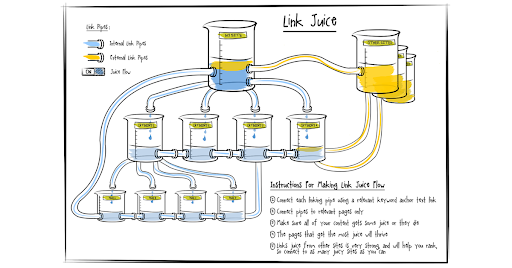
.
Source: Laura Atwell, webmarketsonline.com/blog/articleid/20/the-power-of-link-juice
Figuratively speaking, when we link from our site to another site, we are pouring from our “bucket” into their “bucket.” In contrast, the power of our domain increases when we pour from other sites into our “bucket.”
So what about linking to other sites? Since we are giving away some of our link juice, the default behavior should be not to link to other resources.
Unfortunately, Google has a different take on this. John Mueller said: Linking to other websites is a great way to provide value to your users. Often times, links help users to find out more, to check out your sources and to better understand how your content is relevant to the questions that they have.
Which is to say:
Linking to other sites is a great way to give value to users. Often links help users find out more, check out your sources and better understand how your content is relevant to the question they have.
In other words – linking to credible sources with high authority is beneficial for page experience. In contrast, citing sources and not linking to them will be suspect from Google’s point of view.
How many links from one domain?”
.
It used to be that SEO specialists believed that a maximum of 100 links should go from linking domain A to linking domain B.
MOZ’s Peter J. Meyers said it this way: There’s an inescapable reality in SEO that the more links a page has, the less internal PageRank each of those links passes.
This can be likened to when Elon Musk tweeted that from now on Tesla cars can be paid for in cryptocurrencies, causing the cryptocurrency exchange rate to go up. If Musk had tweeted several times each day about investing in crypto, he would have lost his audience.
Today it is accepted that it is best if only one link goes out from one domain to another domain. Alternatively, if several links are to go out, not from one URL.
Principle of first link counts
.
There are times when a principal orders a sponsored article, and from that article links twice to the same place on his site. Bottom line: why not?
Currently, this is not profitable. According to the “first link counts” rule, only the first link will convey its power.
Place of hyperlink in structure matters
.
When we get a link from Allegro’s homepage, it will convey more power than if it leads to us from the Privacy Policy, or another subpage buried so deep in the structure that even Screaming Frog’s crawler can’t find it.
Link juice a indexation
.
A link that Google can’t see doesn’t convey power. Szymon Slowik at the SEO Poland conference presented a case where the indexation rate of a site was 66.6%. This means that 1/3 of the links from the site are not digging.
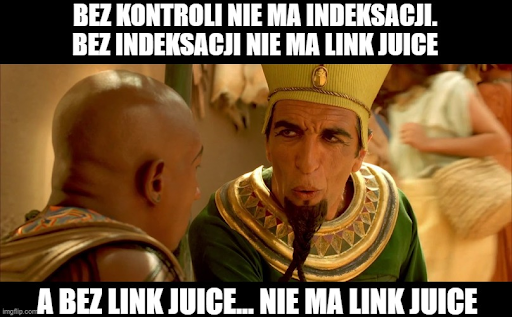
.
Therefore, after ordering a publication with a link, it is a good idea to check whether the content has indexed in Google.
Link juice a rel=”nofollow”
.
The nofollow attribute was a directive to Google’s crawler that told it not to follow a link. We used it when we did not want to pass link juice to the linked site.
Currently, nofollow is only a guideline and it is up to Google’s robot whether to follow it or not.
This means that links with a nofollow attribute can dig.
How to check link juice?
.
Daniel Kahneman, in his book “The Traps of Thinking,” wrote that There is only what you see. In SEO terms, this can be translated as It only exists what you test.
When it comes to links and the power they convey, experts agree – it depends:
- or link copies,
- or not,
.
.
The truth is that until you attach a link to your domain, you won’t know. This was mentioned, for example, by Maciej Chmurkowski in the first episode of the Unnamed Podcast.
.
Szymon Nightingale described the topic very well in a discussion on Facebook:
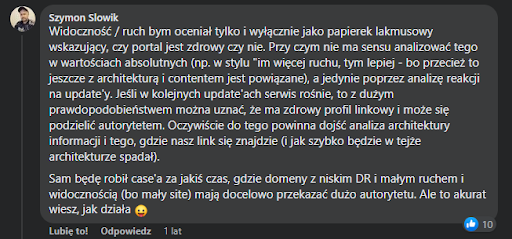
It is not possible to directly determine the amount of link juice transferred. You can only try to estimate it, and that’s what tools are for.
Tools to help you analyze link juice
.
If you have “seo” in your Facebook name or URL on LinkedIn, you’re bound to have people from Asian countries writing to you from time to time with a suggestion.
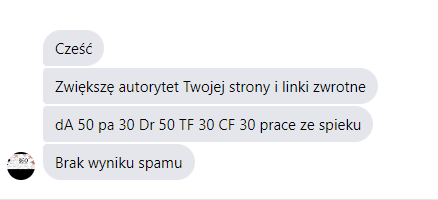
.
These abbreviations between crippled polish stand for indicators from tools. Are they the same as link juice? No. Or at least not exactly.
Ahrefs, Semrush, Majestic, MOZ
.
The developers of these tools have attempted to estimate the link juice value a domain can convey. Ahrefs has UR and DR, Majestic has TF and CF, Semrush and MOZ have DA, but practice shows that each of these indicators can be manipulated.
However, there is something that works flawlessly, namely link profile analysis. Most sites do not block the entry of Ahrefs or Semrush crawlers, so we can approach the links leading to a given site.
In tools of this type, we have the ability to see when, more or less, a given backlink first appeared, and check the correlation with the increase or decrease in organic traffic.
UberSuggest
.
Neil Patel’s tool has one interesting feature – Spam Score. The value shows how many backlinks a domain has from sites with very low, even spammy authority.
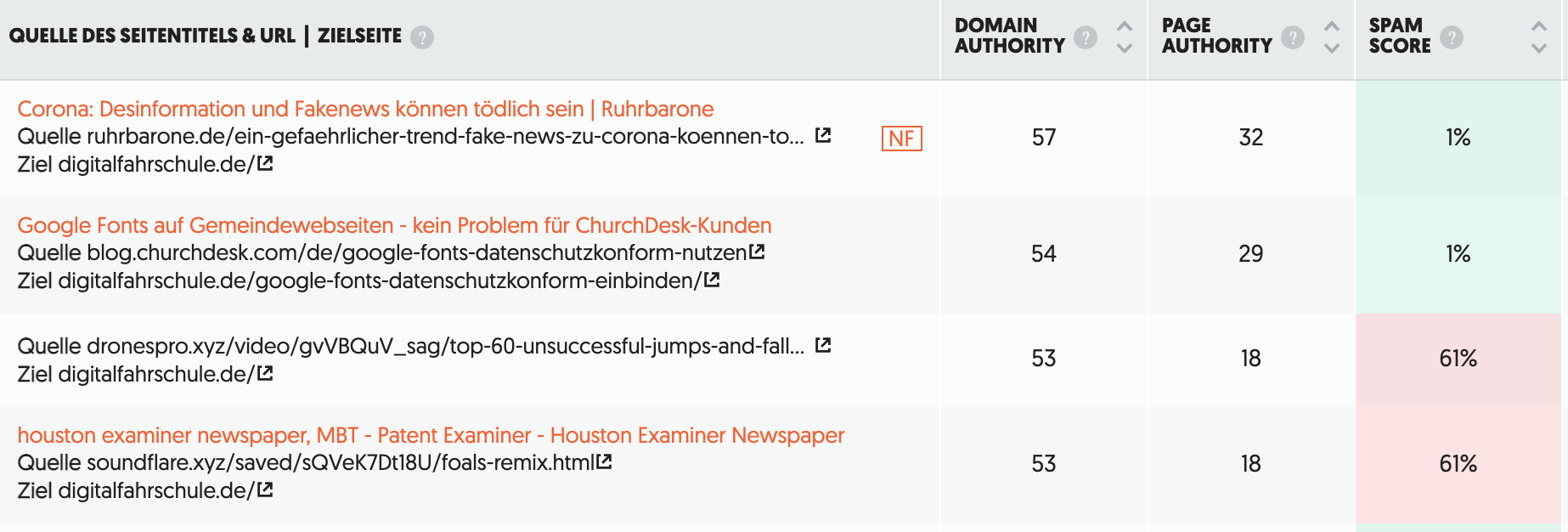
.
Source: digitalfahrschule.de/was-ist-spam-score/
AI Media Planner in WhitePress®
.
The AI Media Planner is a tool for automating the content publishing process. The goal of the tool is one: optimize the time you spend on your daily, often tedious duties. Depending on your needs, you can currently choose between three strategies (there will be more in the future):
- Quick wins,
- Keyword linking,
- Content/press release promotion
.
.
.
Own Brain
.
Luke Zelezny said in one of his webinars that a good link is one that your grandmother would click.
To estimate the level of link juice a domain can convey, one would need to answer a few questions:
- what is the ratio of outbound to inbound links on a given page,
- what % of them are nofollow links,
- what pages link to it,
- what organic traffic the site has,
- where in the structure of this page will link to my domain,
- what is the theme of the page,
- how difficult it is to get a given link,
.
.
.
.
.
.
.
Why is link juice important?
.
Barry Schwartz of Search Engine Land lists three main ranking factors:
- content,
- links,
- RankBrain,
.
.
.
We’ll start at the end. RankBrain, is Google’s self-learning algorithm that evaluates search results for a semantic match to a query. Paul Haahr, a Google engineer, said of it that even Google employees don’t know how it works.
When it comes to content, it’s core SEO. Robert Niechciał in a podcast said that currently SEO without content does not exist. The truth is that content without links will blight. Links without content will not.
However, the quality of content will only push the content and domain to a certain level in the SERP. It will be very hard to climb to the top without links.
At the low level in less competitive, niche industries, simple link gathering will suffice. At the highest level of SEO, where the battle is for the most caloric phrases, specialists take care to distribute link juice evenly across the site, so that the most important phrases get the most power.
Inadequate distribution of link juice on the site is in simple terms a financial loss, because our site will not be in the SERP as high as it could be.
.
 Daniel Bartosiewicz
Daniel Bartosiewicz